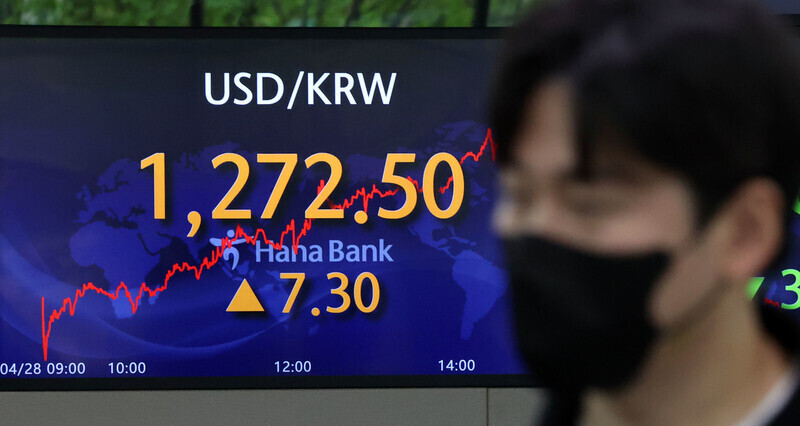hankyoreh
Links to other country sites 다른 나라 사이트 링크
S. Korea’s terms of trade hit worst point in nearly a decade

Despite strong exports, South Korea’s imports have increased significantly due to a surge in energy prices, making the terms of trade the worst in more than nine years. With the won depreciating significantly due to the strong dollar, the country’s terms of trade are likely to deteriorate further.
According to the March 2022 “Trade Indexes & Terms of Trade Indexes” released by the Bank of Korea on Thursday, the net barter terms of trade index in March was 87.30, down 6.3% from the same period last year.
The index was the lowest since November 2012, when it stood at 86.88, with a decline continuing for 12 consecutive months from April last year.
The index measures the quantity of imports that can be purchased through the sale of a single unit of exports. An index of 87.30 indicates that 87 import products can be bought with the money earned by exporting 100 domestic products. This means that the average price of imported goods is higher than the average price of exported goods, and this is due to the continued high price of raw materials due to the pandemic and the crisis in Ukraine.
This worsening trade situation for Korea is also confirmed through the balance of trade figures, which are calculated by subtracting imports from exports. Between April 1 and April 20, the trade balance showed a deficit of US$5.199 billion even though total exports were up by 16.9% compared to the same month last year.
This means that imports have increased significantly despite a boom in exports. As a result, Korea recorded two months of trade deficits this year alone in January and March.
It is highly likely that this pattern will continue going forward, and likely worsen. This is because the value of the won, which affects the price of imported goods, is falling sharply.
Yesterday, the won-dollar exchange rate closed at 1,272.5 won in the Seoul foreign exchange market. This marked the first time in two years and one month that the won surpassed 1,270 won to the dollar — the last time being March 19, 2020 (1,285.7 won), due to the economic shock at the onset of the COVID-19 pandemic.
Usually, a decrease in the value of the won (a rise in the won-dollar exchange rate) also has the effect of enhancing the price competitiveness of export products, and thus serves as a starting point for improving the trade balance. However, given current global circumstances, the chances of this happening this time around are rather slim.
The currency values of Korea’s export rivals are falling more than the won. Specifically, the Japanese yen has reached 130 yen to the dollar, the lowest level in 20 years, and the Chinese yuan has also fallen to its lowest value in two years.
“Korea's exports mainly compete with Chinese and Japanese products, but since the yuan and yen are also weak against the dollar, the price competitiveness is not great due to the decrease in the value of the won,” Joo Won, head of the Economic Research Department at the Hyundai Research Institute told the Hankyoreh.
“The burden of import prices on companies due to the appreciation of exchange rates will be much greater [going forward],” he added.
By Jun Seul-gi, staff reporter
Please direct questions or comments to [english@hani.co.kr]

Editorial・opinion
![[Column] Season 2 of special prosecutor probe may be coming to Korea soon [Column] Season 2 of special prosecutor probe may be coming to Korea soon](https://flexible.img.hani.co.kr/flexible/normal/500/300/imgdb/original/2024/0426/3317141030699447.jpg) [Column] Season 2 of special prosecutor probe may be coming to Korea soon
[Column] Season 2 of special prosecutor probe may be coming to Korea soon![[Column] Park Geun-hye déjà vu in Yoon Suk-yeol [Column] Park Geun-hye déjà vu in Yoon Suk-yeol](https://flexible.img.hani.co.kr/flexible/normal/500/300/imgdb/original/2024/0424/651713945113788.jpg) [Column] Park Geun-hye déjà vu in Yoon Suk-yeol
[Column] Park Geun-hye déjà vu in Yoon Suk-yeol- [Editorial] New weight of N. Korea’s nuclear threats makes dialogue all the more urgent
- [Guest essay] The real reason Korea’s new right wants to dub Rhee a founding father
- [Column] ‘Choson’: Is it time we start referring to N. Korea in its own terms?
- [Editorial] Japan’s rewriting of history with Korea has gone too far
- [Column] The president’s questionable capacity for dialogue
- [Column] Are chaebol firms just pizza pies for families to divvy up as they please?
- [Column] Has Korea, too, crossed the Rubicon on China?
- [Correspondent’s column] In Japan’s alliance with US, echoes of its past alliances with UK
Most viewed articles
- 1The dream K-drama boyfriend stealing hearts and screens in Japan
- 2‘We must say no’: Seoul defense chief on Korean, USFK involvement in hypothetical Taiwan crisis
- 3AI is catching up with humans at a ‘shocking’ rate
- 4S. Korea “monitoring developments” after report of secret Chinese police station in Seoul
- 5[Column] Can we finally put to bed the theory that Sewol ferry crashed into a submarine?
- 6[Editorial] Yoon cries wolf of political attacks amid criticism over Tokyo summit
- 7[Photo] “Comfort woman” survivor calls on president to fulfill promises
- 8Doubts remain over whether Yoon will get his money out of trip to Japan
- 9Up-and-coming Indonesian group StarBe spills what it learned during K-pop training in Seoul
- 10[Editorial] Was justice served in acquittal of Samsung’s Lee Jae-yong?